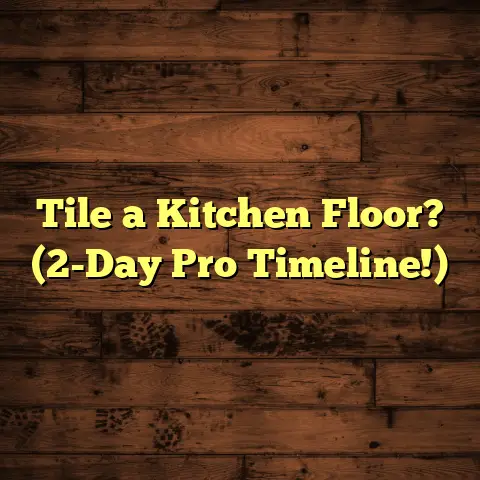Fix Termite Damaged Floor Joists? (7-Day Decay Risk!)
Ever tried building a “dream treehouse”
indoors?
Yeah, me neither.
But I did
once help a client who almost did, until
we found termites had turned their floor
joists into a sawdust buffet.
Talk about
an unexpected plot twist!
Termites… they’re like the tiny ninjas
of home destruction.
Today, we’re diving
deep into the world of termite-ravaged
floor joists, that dreaded 7-day decay
risk, and exactly how to kick those
critters (and their damage) to the curb.
Section 1: Understanding the Enemy
Okay, let’s talk termites.
These little guys are actually important
for the environment.
They break down dead
wood, returning nutrients to the soil.
But
guess what?
They don’t care about your
charming Victorian or your perfectly laid
hardwood floors!
To them, it’s all just
lunch.
There are a few main types you’ll encounter:
Subterranean Termites: These are the most common and destructive.
They live in the soil and build mud tubes to reach wood.
Think of them as underground tunnel engineers with a serious wood appetite.Drywood Termites: These guys don’t need soil contact.
They live inside the wood they’re eating.
Imagine having uninvited roommates who are also demolishing your house.Dampwood Termites: As the name suggests, they love damp, decaying wood.
They’re often found in areas with leaks or poor ventilation.
Think of them as the ultimate partygoers at a water-damaged wood rave.
These termites work tirelessly, 24/7.
They’re like tiny, relentless construction
workers, except instead of building,
they’re demolishing.
And they do it with
a silent efficiency that’s truly terrifying.
Section 2: Identifying Termite Damage
So, how do you know if you’ve got these
unwelcome guests?
Here’s what to look
for in your floor joists:
Hollow-Sounding Wood: Tap on your joists with a hammer.
Does it sound solid, or hollow?
Hollow means they’ve been snacking.
It’s like knocking on a door and hearing nothing but an echo of your home’s structural integrity.Frass (Termite Droppings): This looks like tiny wood-colored pellets.
It’s basically termite poop.
Finding this near your joists is a major red flag.
Think of it as the calling card of destruction.Mud Tubes: These are pencil-thin tubes made of mud that subterranean termites use to travel from the soil to the wood.
They’re like tiny highways for destruction.Sagging Floors: This is a more advanced sign of damage.
If your floors are starting to sag, it means the joists are significantly weakened.
Imagine walking on eggshells… except the eggshells are your floors and the “yolk” is the potential for disaster.Visible Damage: Sometimes, you can actually see the damage.
Look for holes, tunnels, or weakened areas in the wood.
I once inspected a house where the
homeowner said the floor “felt a little
soft.” A little soft?
I stepped on it and
my foot went right through!
The termites
had turned the joists into something
resembling papier-mâché.
It was a scene
straight out of a home repair horror movie.
Section 3: The 7-Day Decay Risk
Now, let’s talk about that 7-day decay risk.
Untreated termite damage creates a perfect
environment for wood decay fungi.
These
fungi can cause serious structural
problems, and they can spread rapidly.
That’s where the 7-day thing comes in.
In ideal conditions (warm, damp), wood
decay fungi can start to significantly
weaken already damaged wood within a week.
Think of it as a tag team of destruction:
first, the termites weaken the wood, then
the fungi move in for the knockout.
It’s like a ticking time bomb under your
house!
Every day you delay, the problem
gets worse, and the repair becomes more
expensive.
Imagine a slapstick comedy
scene where the floor suddenly collapses
during a fancy dinner party.
That’s what
we’re trying to avoid here.
According to the USDA Forest Service, decay can reduce the strength of wood by as much as 50% in a relatively short period.
That’s why it’s crucial to address termite damage immediately.
Section 4: Preparing for Repair
Alright, time to roll up our sleeves and get to work. But first, safety!
Safety Gear: Wear safety goggles, a dust mask, gloves, and old clothes.
Trust me, those safety goggles might not make you look cool, but they’ll save you from looking like a “home repair horror story.”Clear the Area: Remove furniture, rugs, and anything else that might get in the way.
You need a clear workspace.Ventilation: Open windows and doors to ventilate the area.
You’ll be dealing with dust, debris, and possibly some chemicals, so good ventilation is essential.Support: If the damage is extensive, you may need to temporarily support the floor joists with jacks and shoring.
This is crucial to prevent further collapse.
Now, let’s gather our tools and materials:
-
Tools: Hammer, saw (circular saw and reciprocating saw), level, measuring tape, drill, screwdriver, pry bar, chisel, safety glasses, dust mask, gloves.
-
Materials: New lumber (same size and grade as the existing joists), wood preservative, construction adhesive, nails or screws, shims.
Think of your tools as your trusty sidekicks
in this battle against the termites.
Each
tool has a specific purpose, and you’ll
need them all to succeed.
Section 5: Step-by-Step Repair Process
Okay, let’s get down to the nitty-gritty.
Here’s how to fix those termite-damaged
floor joists:
Step 1: Assess the Damage
Carefully inspect the joists to determine
the extent of the damage.
Probe the wood
with a screwdriver to see how far the
damage goes.
Mark the areas that need
to be removed.
Step 2: Remove Damaged Material
Using a saw, cut out the damaged sections
of the joist.
Make sure to cut back to
solid, healthy wood.
Use a pry bar to
remove any loose or rotten pieces.
Safety Tip: Always wear safety glasses when cutting or prying wood.
Step 3: Treat Remaining Wood
Apply a wood preservative to the remaining
wood to kill any lingering termites or
fungi, and to protect against future
infestations.
Follow the manufacturer’s
instructions carefully.
Step 4: Measure and Cut New Joist Section
Measure the gap where you removed the
damaged section.
Cut a new piece of lumber
to fit the gap.
Make sure the new piece
is the same size and grade as the existing
joist.
Pro Tip: Double-check your measurements
before cutting!
It’s better to be a little
too long than too short.
Step 5: Install the New Joist Section
Apply construction adhesive to the ends
of the new joist section.
Place the new
section into the gap, making sure it’s
flush with the existing joists.
Step 6: Secure the New Joist Section
Nail or screw the new joist section to
the existing joists.
Use plenty of
fasteners to ensure a strong connection.
You can also use metal reinforcement
plates for added strength.
Industry Secret: Use galvanized nails or screws to prevent rust.
Step 7: Add Support (If Needed)
If the joists are heavily damaged, you
may need to add additional support.
This
can be done by sistering a new joist
alongside the existing one, or by
installing additional support posts.
Step 8: Check for Level
Use a level to make sure the new joist
section is level with the existing joists.
If necessary, use shims to adjust the
height.
Step 9: Clean Up
Remove all debris and dispose of the damaged wood properly.
I once had a client who insisted on
reusing the termite-damaged wood for a
“rustic” art project.
I tried to explain
that it wasn’t a good idea, but they
wouldn’t listen.
A few weeks later, they
called me back complaining of termites
in their living room.
Sometimes, you just
can’t fix stubbornness.
Section 6: Preventing Future Infestations
Okay, you’ve fixed the damage.
Now, how
do you keep those pesky termites from
coming back?
Preventive Treatments: Apply a termite treatment to the soil around your foundation.
This will create a barrier that termites can’t cross.
There are DIY options, but I usually recommend hiring a professional for this.Proper Ventilation: Make sure your crawl space is properly ventilated.
This will help to prevent moisture buildup, which termites love.Remove Wood Debris: Clear away any wood debris around your foundation.
This includes firewood, mulch, and old lumber.
These are all potential food sources for termites.Fix Leaks: Repair any leaks in your plumbing or roofing.
Termites are attracted to moisture.Regular Inspections: Schedule regular termite inspections.
A professional inspector can spot problems early, before they become serious.
Here’s a humorous “do’s and don’ts” list for termite prevention:
Do:
- Keep your home clean and dry.
- Maintain your landscaping.
- Be vigilant for signs of termites.
Don’t:
- Invite termites over for dinner.
- Use termite-damaged wood for art projects.
- Ignore signs of termite infestation.
Remember, preventing termites is much easier (and cheaper) than repairing termite damage.
Section 7: Conclusion
So, there you have it! A comprehensive guide to fixing termite-damaged floor joists.
It’s not the most glamorous job, but it’s essential for protecting your home.
Termites may be small, but their impact
can be huge.
Don’t let them turn your
dream home into a nightmare.
Take action
today!
And remember, a little bit of prevention
goes a long way.
Keep those termites at
bay, and your floor joists (and your feet)
will thank you.
Call to Action
Now, I want to hear from you!
What are your funniest (or most disastrous)
home repair stories?
Share them in the
comments below!
Let’s laugh together and
learn from each other’s mistakes.
And if
you have any questions about termite
damage, feel free to ask.
I’m here to
help!





